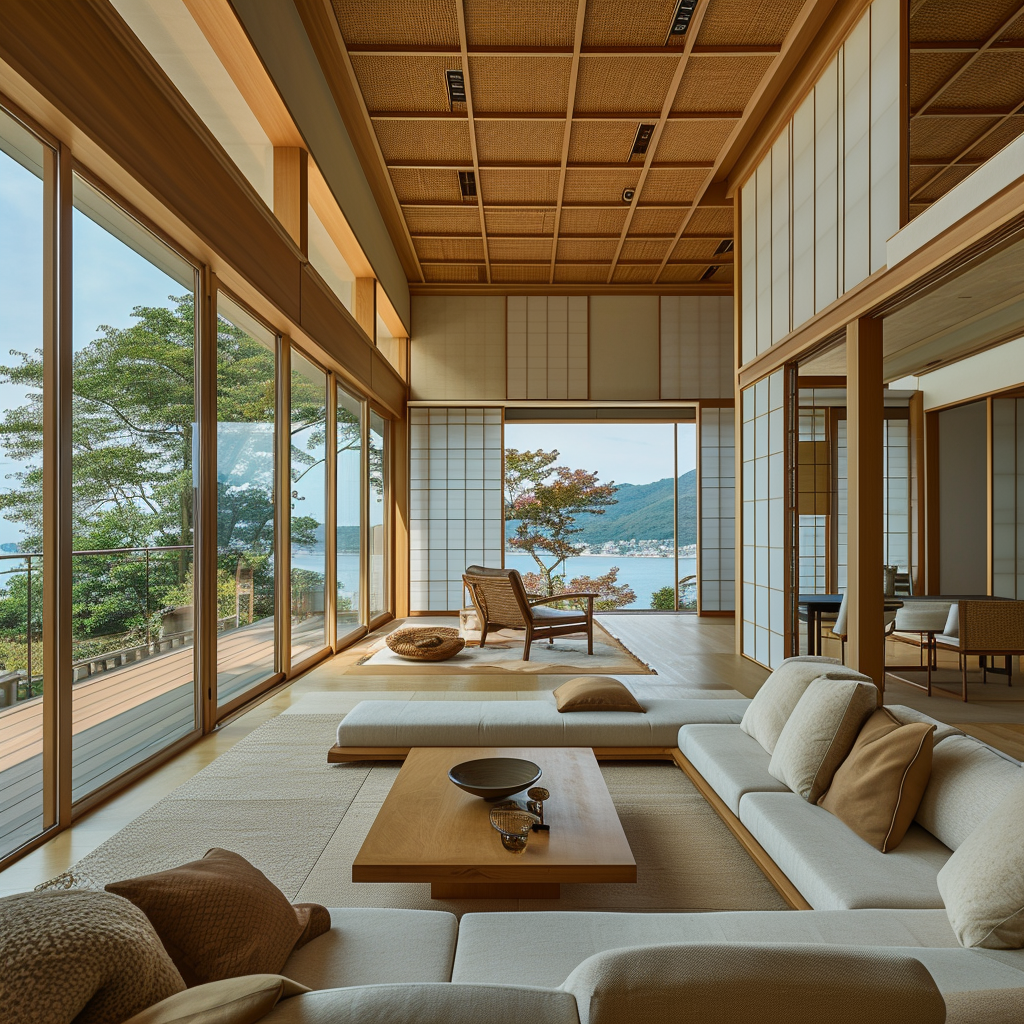Japanese style living rooms are characterized by simplicity, natural materials, neutral colors, and symbolic decor. Incorporating WABI paper, room dividers, and minimalist furnishings create a serene and harmonious space.
The fusion of Japanese and Scandinavian design philosophies, known as Japandi style, emphasizes simplicity and coziness, making it a popular choice for modern interiors. By integrating elements that bring nature indoors and reducing clutter, a Japanese style living room promotes a sense of tranquility and balance.
Embracing these design principles can transform any space into a peaceful retreat inspired by Japanese aesthetics.
Essence Of Japanese Style Living Rooms
Japanese style living rooms embody tranquility and simplicity. The design focuses on creating harmonious spaces that promote relaxation and mindfulness. From the furniture to the decor, every element is carefully chosen to reflect the beauty of nature and the essence of Japanese culture.
Key Features Of Japanese Interior Design
- Natural Materials & Textures: Wood, bamboo, and rice paper are commonly used to bring a sense of nature indoors.
- Neutral Color Palette: Soft earth tones like beige, grey, and brown are favored to create a serene atmosphere.
- Minimalist Furnishings: Simple, low-profile furniture pieces with clean lines contribute to the uncluttered aesthetic.
- Shoji Screens: Sliding paper screens are used to divide spaces while allowing natural light to filter through.
The Role Of Minimalism And Functionality
Minimalism and functionality are at the core of Japanese interior design. By focusing on essential elements and removing excess clutter, Japanese living rooms promote a sense of calm and order. Every piece of furniture serves a purpose, emphasizing practicality without sacrificing beauty.
Incorporating Natural Elements
When designing a Japanese style living room, incorporating natural elements is essential for creating a serene and harmonious space. The use of wood, bamboo, plants, and water features brings the essence of nature indoors, promoting a sense of tranquility and balance.
Use Of Wood And Bamboo
The use of wood and bamboo in a Japanese style living room adds warmth and organic texture to the space. Opt for furniture crafted from natural wood, such as oak, maple, or walnut. Additionally, bamboo screens, blinds, or flooring can be incorporated to infuse an authentic touch of Japanese aesthetics.
Incorporating Plants And Water Features
Introducing plants and water features further enhances the natural ambiance of a Japanese style living room. Consider adding a small indoor garden with bonsai trees, bamboo plants, or peace lilies. A water feature like a small fountain or a miniature rock garden with a trickle of water can create a soothing focal point.
Color Schemes And Materials
When it comes to Japanese style living rooms, the choice of color schemes and materials plays a crucial role in creating a harmonious and calming atmosphere.
Neutral Tones And Soft Textures
In Japanese style living rooms, neutral tones such as beige, cream, and soft grey are commonly used to create a sense of tranquility.
Soft textures like natural wood, bamboo, and linen are often incorporated to add warmth and depth to the room.
Traditional Fabrics And Finishes
Japanese living rooms feature traditional fabrics such as silk, cotton, and washi paper which add a touch of elegance and authenticity.
Natural finishes like matte wood, stone, and bamboo are used to create a connection with nature.

Credit: www.pinterest.com
Furniture Choices
When designing a Japanese style living room, the choice of furniture plays a crucial role in creating an authentic and serene atmosphere. From low-profile seating to the use of traditional tatami mats, each furniture selection contributes to the overall ambience of the space.
Selecting Low And Functional Furniture
In a Japanese style living room, the emphasis is on simplicity and functionality. Low furniture such as floor cushions, low coffee tables, and floor sofas are popular choices. These pieces not only promote a comfortable and relaxed seating arrangement but also contribute to an open and uncluttered space. The minimalist design of low furniture aligns with the Japanese concept of Ma, which emphasizes the importance of negative space and simplicity in design.
The Importance Of Tatami Mats
Tatami mats hold significant cultural and practical importance in Japanese interior design. These traditional straw mats are used as flooring in Japanese homes and are often employed in the living room area. Tatami mats provide a natural and earthy feel to the space, while their soft texture adds warmth and comfort. Additionally, the use of tatami mats aligns with the concept of Zashiki, the traditional Japanese style of sitting on the floor, which is often incorporated into the design of a Japanese living room.
Lighting And Space
When designing a Japanese style living room, the use of lighting and space is crucial to creating a serene and harmonious environment. The interplay of natural light and the arrangement of furniture and decor can significantly impact the overall ambiance of the room.
Natural Lighting Techniques
Incorporating natural lighting is a fundamental aspect of Japanese interior design. Large windows and sliding doors allow ample sunlight to filter into the room, creating a warm and inviting atmosphere. Paper lanterns and shoji screens are traditional elements that diffuse light softly, adding a touch of authenticity to the space.
Creating A Sense Of Spaciousness
Maximizing the sense of spaciousness is essential in a Japanese style living room. Furniture arrangement plays a key role, with a focus on simplicity and minimalism. Low-profile seating such as floor cushions and low tables not only contribute to the aesthetic but also create an open and uncluttered feel. Neutral color schemes and clean lines further enhance the perception of space, promoting a tranquil and balanced environment.

Credit: edwardgeorgelondon.com
Decorative Elements
A Japanese style living room is characterized by its serene and minimalist design, with a focus on creating a harmonious and tranquil space. Decorative elements play a crucial role in enhancing the aesthetic appeal of the room. Let’s explore some key decorative elements that contribute to the unique ambiance of a Japanese style living room.
Use Of Scrolls And Artwork
In traditional Japanese interior design, the use of scrolls and artwork holds significant importance. These decorative pieces often feature calligraphy, nature-inspired motifs, or scenes from Japanese folklore. Scrolls are typically displayed on alcoves called tokonoma, which serve as a focal point in the room. The artwork is carefully chosen to reflect the principles of harmony, balance, and simplicity, adding a touch of cultural elegance to the living space.
Minimalist Decorative Approach
Embracing a minimalist approach to decoration is integral to Japanese style living rooms. The concept of “less is more” is deeply ingrained in Japanese aesthetics. Decorative items are carefully curated, with an emphasis on quality over quantity. Simple yet elegant ornaments, such as ceramic vases, bonsai plants, or ikebana flower arrangements, are strategically placed to bring a sense of tranquility and refinement to the room. The minimalist decorative approach fosters a serene atmosphere and allows the natural beauty of each element to shine through.
Integrating Modern Touches
Japanese style living rooms are known for their serene and minimalist design, but that doesn’t mean they can’t benefit from modern touches. By integrating modern elements, you can create a space that seamlessly blends traditional Japanese aesthetics with contemporary design.
Blending Traditional With Contemporary
When incorporating modern touches into a Japanese style living room, it’s essential to strike a balance between traditional and contemporary elements. This can be achieved by pairing classic Japanese design features with modern furniture and decor.
Technology In A Japanese Setting
Integrating technology into a Japanese style living room requires a thoughtful approach to maintain the space’s harmony. Consider incorporating sleek, minimalist technology such as smart lighting, hidden entertainment systems, and innovative gadgets that complement the overall design aesthetic.
Case Studies And Examples
Transform your space with Japanese style living room case studies and examples. Discover modern minimalist designs, cozy floor seating, and Japanese furniture to create a serene and tranquil living room inspired by the principles of Japanese interior design. Incorporate natural materials, neutral colors, and symbolic decor for an authentic touch.
Real-life Japanese Style Living Rooms
Discover real-life examples of Japanese style living rooms that showcase the essence of simplicity and harmony.
- Minimalist furniture arrangements
- Use of natural materials like wood and bamboo
- Low seating options such as floor cushions
- Subdued color palettes with accents of nature-inspired hues
Adapting Japanese Elements In Western Homes
Explore how Western homes incorporate Japanese design elements to create a fusion of styles.
- Integration of sliding shoji doors
- Incorporation of tatami mats for flooring
- Installation of traditional Japanese lighting fixtures
:strip_icc()/japanese-dining-rooms-13-d84e735c347f4a9cb9cfc1c5e34d905e.png)
Credit: www.mydomaine.com
Conclusion
Creating a Japanese style living room is all about simplicity, natural elements, and incorporating symbolic decor. By utilizing neutral colors, integrating simple furnishings, and reducing clutter, you can achieve a minimalist yet cozy space. Additionally, incorporating WASHI paper and room dividers can add a unique touch to your design.
Whether you’re going for a modern or traditional look, following these principles will help you create a serene and inviting Japanese style living room.
